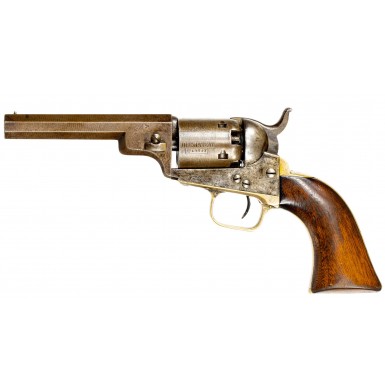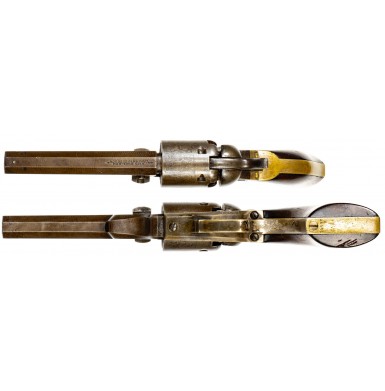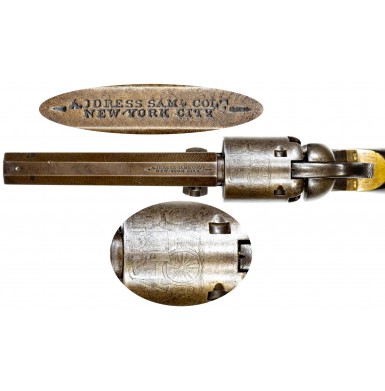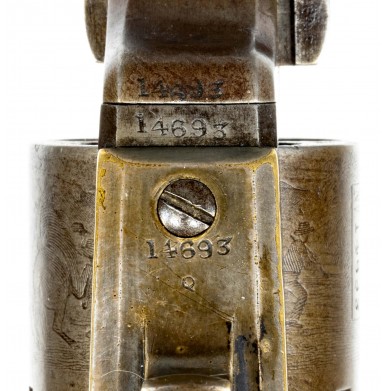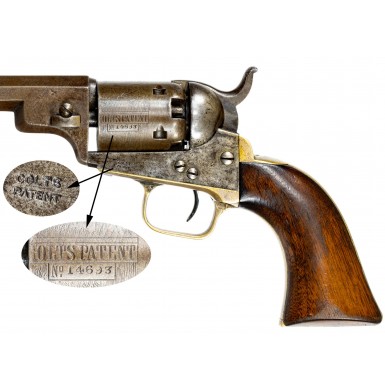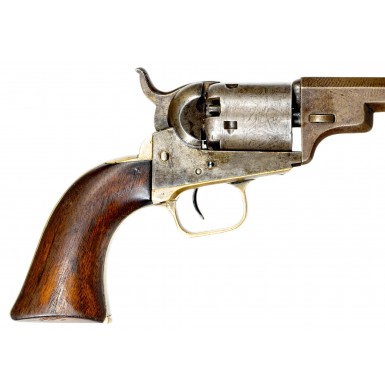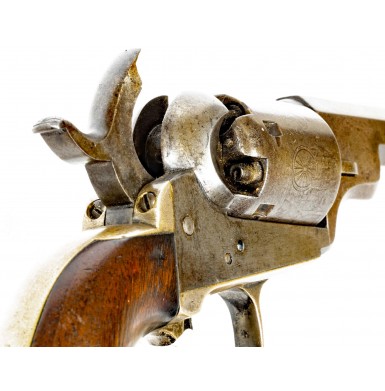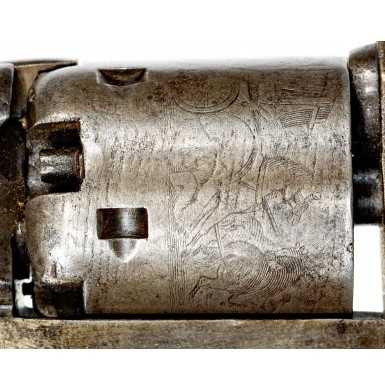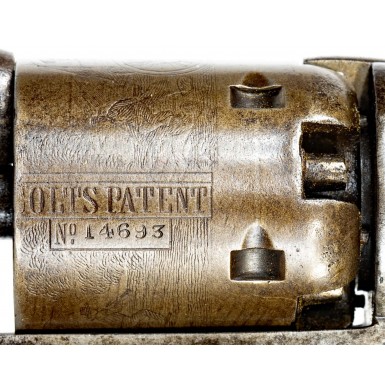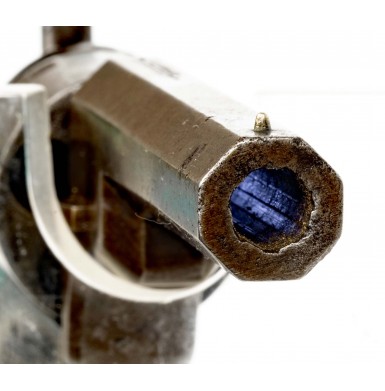Extremely Rare 4-inch Colt M1849 "Wells Fargo" Pocket Revolver - ex-Locke Collection
- Product Code: FHG-2223-SOLD
- Availability: Out Of Stock
-
$1.00
This is a VERY GOOD condition example of a very scarce, 4” barreled Colt Model 1849 “Wells Fargo” Pocket Revolver. The M1849 Colt Pocket was the most successful percussion handgun ever produced by Colt, with more than 325,000 being manufactured in the United States between 1850 and 1873, and another 11,000 or so being produced at Colt’s short-lived London manufactory. The 1849 Pocket was an improved version of the M1848 Pocket Revolver, better known to collectors as the “Baby Dragoon”, which had first been manufactured in 1847 and remained in production through 1850, when the M1849 Pocket Revolver superseded it. The “Baby Dragoon” had found a ready market among those who were taking part in the rapid westward expansion of the United States and were prized possessions in the California gold fields of the 1849 Gold Rush. The relatively short barrel (typically 3” to 6”), the compact 5-shot cylinder and the small .31 caliber chambering all combined to make a relatively light weight (around 22 ounces or 1 pound 6 ounces with a 5” barrel) and compact revolver that could be carried covertly in a jacket or trouser pocket. The “Baby” did have some drawbacks, the most obvious being the lack of an attached loading lever on the majority of the production. The other issue was the square backed triggerguard, which could be caught on the edge of a pocket when the gun was pulled from hiding. The improved version, the M1849 Pocket included an attached loading lever on all by the shortest barreled versions and a rounded trigger guard. Other changes from the early production “Baby Dragoons” that were standard on the 1849 had appeared as improvements on later M1848s. These included an improved action with a roller on the bottom of the hammer, grease grooves on the cylinder arbor pin, and rectangular cylinder stop slots with a rounded concave profile along their leading edge. This improvement had been patented by Colt in 1850, was incorporated in all of their future percussion revolver designs and is still a feature found on nearly every revolver in production today. The 1849 Pocket also incorporated the roll engraved “Stagecoach Hold Up” cylinder scene that had been introduced during the latter part of Baby Dragoon production.
The Colt Pocket went into production in 1850, concurrently with the Baby Dragoon, and continued in the same serial number range. This means that early 1850 production (which started around serial 12,000) contained a mixture of “Baby” and “Pocket” revolver numbers overlapping within the same series, with the “Pocket” finally becoming the only handgun in that serial number range towards the end of 1850 (somewhere around serial numbers 14,000-15,000). The Colt M1849 Pocket was produced in more variations than any other Colt revolver and it is generally estimated that a collection of about two hundred M1849s would be necessary to cover all of the primary variants.
Due to the wide variety of features available, a “standard” M1849 is hard to define, but in general a typical M1849 was a 5 or 6 shot .31 caliber single action percussion revolver with an octagon barrel that was typically between 3” and 6” in length, usually with an attached loading lever. The backstrap, gripstrap and triggerguard were usually of silver plated brass, and the revolver was blued with a color case hardened frame and hammer. Standard grips were varnished one-piece walnut. The revolvers were, however, available with a dizzying array of finishes, barrel lengths, grip options, and engraving. Cased sets, complete with all the necessary accouterments to load and operate the revolver were available as well; both directly from Colt and from Colt retailers.
One of the rarest and most desirable of the Colt M1849 Pocket Revolver variants produced is the type call the “Wells Fargo” model by collectors. This is simply a collector’s term, and these interesting variant M1849s have nothing to do with the Wells Fargo company, nor are any examples known with legitimate Wells Fargo markings. However, since the nickname has been in use by collectors for so many decades, there is little likelihood that the term will ever be dropped from use. From a visual standpoint, the “Wells Fargo” M1849 Pocket Revolver was simply a Model 1849 produced without an attached rammer and without the plunger hole cut in the frame. In reality, the earliest examples were simply an attempt by Colt to use up existing stocks of Baby Dragoon parts and are more accurately described as Baby Dragoons with the rounded triggerguard of the M1849 Pocket. The “Wells Fargo” model was produced in two distinct serial number ranges and have two distinct frame sizes. The earliest guns are found in the 14,462 to 63,348 serial number range, circa 1850-1853, as research by authors Robert Jordan and Darrow Watt explain in their book Colt’s Pocket ’49 – Including the Baby Dragoon & Wells Fargo. The authors estimate that about 2,200 “Wells Fargo” models were produced in this serial number range, using up old Baby Dragoon parts and have a frame that is nominally 2 ½” in length. These guns were primarily produced with 3” barrels, but between 100 and 125 were produced with 4” barrels. The next batch of “Wells Fargo” revolvers were produced in the 78,488 to 164,182 serial number range, circa 1853-1860. These guns have a longer, nominally 2 5/8” long frame and are produced of all newly made M1849 Pocket parts, using none of the left over Baby Dragoon parts. All of these later production “Wells Fargo” models were produced with 3” barrels. Nearly twice as many of the later production “Long Frame” “Wells Fargo” revolvers were produced, with an estimated production of about 4,200. While the use of old, obsolete parts on hand to produce guns is completely understandable and makes perfect economic sense, the reason behind the production of the later “Wells Fargo” models is more confusing. As one of the biggest complaints about the Baby Dragoon was the lack of an attached ramrod, the logic behind introducing a rammerless version of the M1849 Pocket is somewhat unclear. Obviously, Colt felt that there was a market for a compact, lighter than standard weight self-protection concealment model of the gun. The theory was likely that these guns would be loaded and carried discretely and would not see heavy use requiring regular reloading, the classic firearms adage: “fired a little, but carried a lot”. The same marketing theory was certainly behind the later production Colt M1873 and M1877 revolvers in their ejectorless “Sherriff’s Model” and “Shopkeeper’s Model” variants. The theory is further supported by the fact that the later production guns were only produced in the shorter, 3” barreled, variation. Any size and weight savings created by deleting the ramrod assembly were apparently less apparent with the 4” version. Clearly these models did not sell all that well, as only about 6,400 “Wells Fargo” M1849s were produced in both formats, representing slightly less than 2% of all M1849 production. The unpopular 4” version of the “Wells Fargo” revolver represents slightly less than 2% of all “Wells Fargo” production, and only about .0003% of all M1849 Pocket revolver production, making them exceedingly rare.
The Colt M1849 “Wells Fargo” Pocket Revolver offered here is an extremely scarce and very desirable 4” example, which as noted represents less than 2% of all “Wells Fargo” production and less than .0003% of all M1849 Pocket production. The revolver is a classic, early production “short frame” example with a nominally 2 ½” frame, a Baby Dragoon style cylinder arbor without any grease grooves and no roller on the hammer. The grease grooves and hammer roller were standard features on the M1849 Pocket and are found on the later production “Wells Fargo” revolvers as well. These are clearly left over Baby Dragoon parts. The 4” octagonal barrel is also a left over Baby Dragoon barrel and has never had the web cut for a loading lever plunger. The barrel is marked on top with the two-line New York address with dashed finials at either end. The address reads:
- ADDRESS SAML COLT-
NEW YORK CITY
The revolver is in VERY GOOD overall condition, although it retains no finish. The serial number 14693 is clearly stamped on the bottom of the barrel, the frame, the triggerguard on the butt of the revolver, and on the cylinder. All of the serial numbers are matching throughout, with the exception of the wedge, which is an old replacement. The cylinder arbor is numbered 693, and the grip appears to be numbered 693 as well, written in a weak period ink in the backstrap groove. The revolver is 100% complete, correct and original in all respects with the exception of the replaced wedge and a single replaced screw in the bottom of the butt. Amazingly the gun remains very crisp and sharp throughout, considering that it retains no finish and was likely saw significant use being carried in a pocket during its service life. The cylinder has the usual COLTS PATENT panel box, over the box containing the serial number No 14693. The revolver is crisply and clearly marked on the lower left side of the frame with a small COLTS / PATENT mark without serifs. There is no caliber mark on the rear left web of the triggerguard, however a small V factory inspection mark is present on the front left web. The factory inspection mark Q is present below the serial number under the triggerguard.
The revolver is accompanied by a letter from author Robert Jordan, confirming the correct features of the revolver and the authenticity of this “Wells Fargo” revolver. The gun also has impeccable provenance, having been part of the famous Willian Locke collection and is pictured on page 38 of the book Colts from the William M. Locke Collection by Frank Sellers. It also appears on page 67 of Sellers' The William M. Locke Collection and is listed in the database of Colt Pocket revolvers in P.L. Shumaker’s Colt’s Variations of the Old Model Pocket Pistol 1848-1872.
As noted, the gun is in VERY GOOD condition. It retains none of the original blued finish and has a moderately oxidized brown patina on the barrel with a mottled gray patina on the casehardened frame and hammer, creating the impression of faded and dulled color patterns that are no longer present. The metal is mostly smooth, with a couple of small patches of pitting on the barrel and some more evenly distributed light to moderate pinpricking here and there. There is also surface erosion present on the face of the muzzle. The pistol shows almost none of the usual impact marks on the right side of the barrel web where the wedge had been knocked out of the pistol during its service life, usually there are numerous bumps and dings in this area. The although the frame shows only a mottled dark over light gray patina, it remains smooth, with crisp edges and clear markings. The cylinder retains no finish either, and has an oxidized brown patina that matches the barrel well. The five-shot cylinder is fairly crisp and retains at least 70%+ of the roll engraved scene, showing the expected wear of a gun that was carried extensively in a pocket. The Stagecoach Holdup scene roll engraved on the cylinder rates VERY GOOD+ and is mostly clear. All of the cones (nipples) in the cylinder are original and they are very crisp, but do show use, with moderate pinpricking and moderate surface oxidation visible in their recesses and around the rear of the cylinder. There is also some light pinpricking on the face of the cylinder from firing and use. The safety pins on the rear face of the cylinder are in very nice shape with four rating at least VERY GOOD and only one being mostly battered and worn. The brass grip frame, grip strap and trigger guard retain about 10%+ of their original silver-plating, which is tarnished and dull. The action of the revolver is VERY GOOD, and the gun functions correctly, timing, indexing and locking up very tightly. The action of the pistol is quite crisp. All of the screws are original with the exception of the one in the bottom of the grip, and most are extremely crisp, with only a couple showing any noticeable slot-wear. The bore of the revolver is in GOOD+ condition. It is moderately oxidized and mostly dark but retains very good rifling along its entire length. There is light to moderate pitting scattered along the entire length of the bore, indicative of a gun that saw at least moderate amounts of use and consistent with the condition of the cylinder chambers and lack of finish on the metal. The original brass cone-shaped post front sight is in place on the top of the barrel, near the muzzle. The civilian style, one-piece, varnished walnut grip is in about GOOD condition. As noted, the grip is weakly numbered to the revolver and fits the frame of the gun perfectly. The grip retains none of its original varnish and has been lightly sanded with some oil finish added. The grip is solid and complete, and is free of any breaks, cracks or repairs. The grip does show some scattered bumps and dings from handling and use, as would be expected, but these are less noticeable due to the sanding.
Overall this is a very solid, relatively crisp example of an incredibly scarce 4” Colt M1849 “Wells Fargo” Revolver. The gun is completely authentic and has wonderful provenance having come from the famous William Locke collection and having been published in books about his collection. For a really advanced Colt collector, this is one of the true “holy grail” revolvers, as only 100 to 125 were produced and only a handful of these scarce guns are known to survive today.
SOLD
Tags: Extremely, Rare, 4, inch, Colt, M1849, Wells, Fargo, Pocket, Revolver, ex, Locke, Collection



